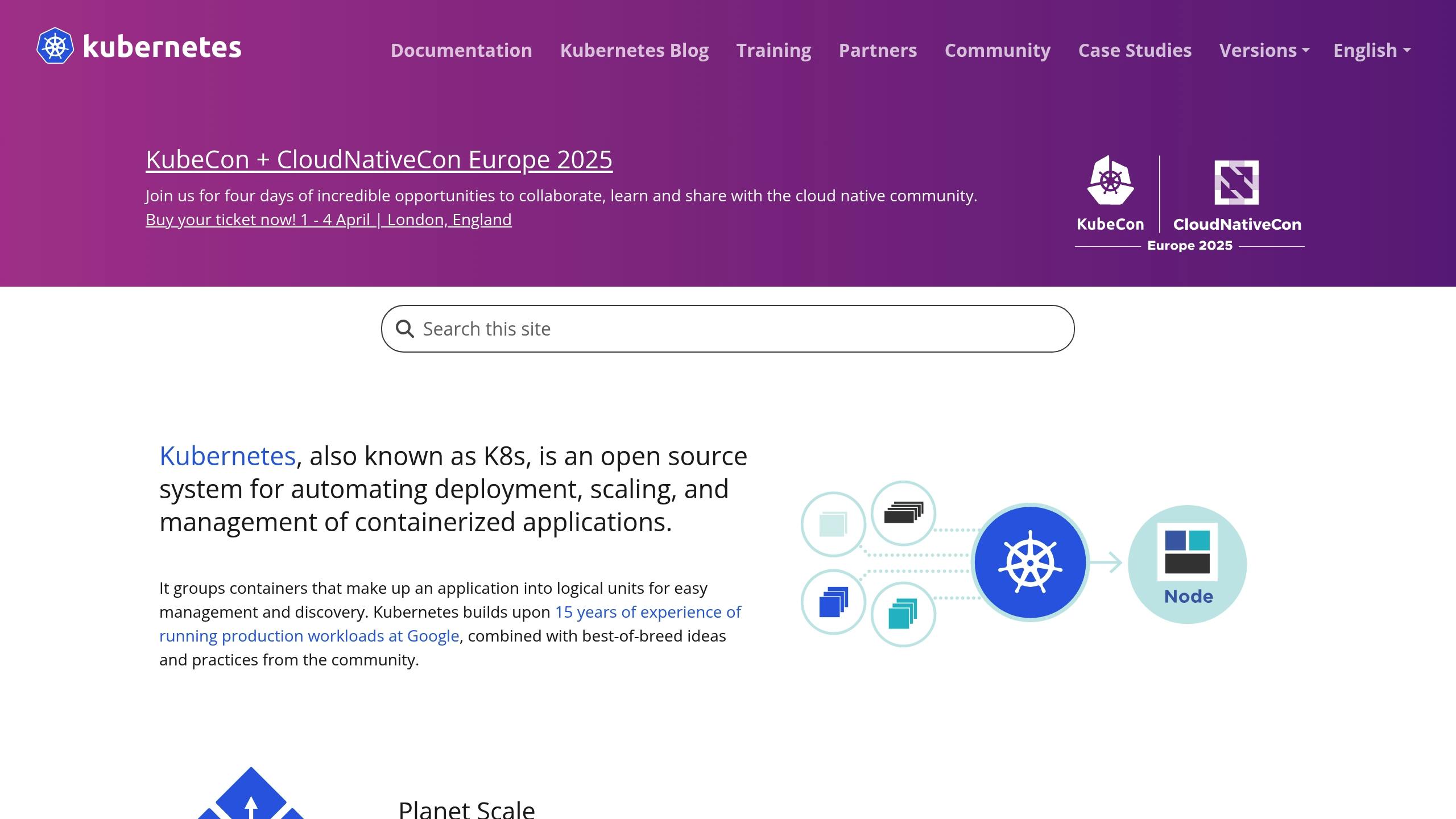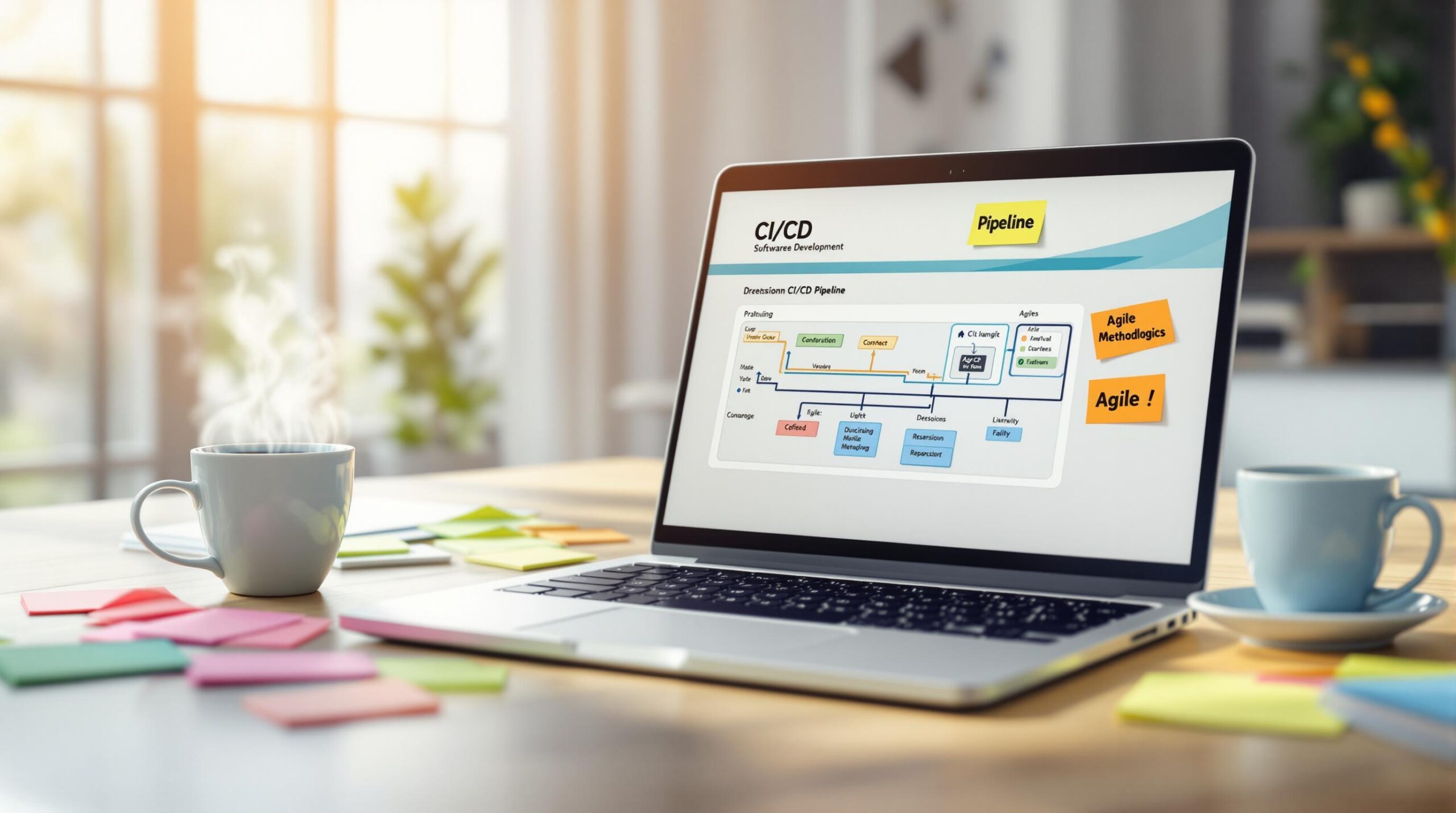Kubernetes and Docker serve different but complementary purposes in DevOps. Docker is ideal for creating and running containers in local or single-host environments, while Kubernetes excels at managing and scaling containers across large, multi-node clusters.
Key Takeaways:
- Use Docker for local development and small-scale projects.
- Use Kubernetes for enterprise-level applications requiring auto-scaling, fault tolerance, and multi-cloud deployments.
Quick Comparison:
| Feature | Docker | Kubernetes |
|---|---|---|
| Primary Function | Container creation and runtime | Cluster orchestration and scaling |
| Scaling | Manual | Automated based on metrics |
| Max Nodes | Single host | Up to 5,000 nodes |
| Best Fit | Development, small-scale apps | Enterprise, multi-service setups |
| Security | Basic | Advanced (RBAC, network policies) |
For small teams, Docker simplifies workflows. For enterprises managing 20+ services, Kubernetes is the better choice for scalability and reliability.
Main Differences: Kubernetes vs Docker

How Each Tool Works
Docker is all about container runtime operations. It packages applications into neat, standardized units that work the same way across different environments. Kubernetes, on the other hand, uses a control plane to handle pod scheduling and manage their state automatically [1][2].
The key difference lies in their scope. Docker mainly operates at the single-node level, focusing on container runtime tasks. It supports container-to-container communication with its basic networking model but needs manual setup for communication across nodes [1].
Kubernetes takes things further with its control plane, automating pod scheduling and using DNS-based service discovery. It supports clusters with up to 5,000 nodes, compared to Docker’s single-host approach [2]. This difference plays a big role in scaling, as highlighted in our microservices case study below.
Feature Comparison
Here’s how the features stack up between Docker and Kubernetes:
| Feature | Docker | Kubernetes |
|---|---|---|
| Primary Function | Container creation and runtime management | Multi-cluster orchestration and automation |
| Scaling Capability | Manual scaling via CLI | Automatic horizontal scaling with metrics integration |
| Resource Management | Basic runtime flags (–memory, –cpu) | YAML-based allocation with Quality of Service (QoS) classes |
| Network Management | Basic overlay networks | Advanced service discovery with stable IPs |
| High Availability | Manual failover handling | Automatic pod replication and self-healing |
| Default Node Limit | Single host | 5,000 nodes |
This comparison highlights Kubernetes’ strength in enterprise environments, offering automated scaling and detailed resource management. For instance, in a deployment of 500 containers, Kubernetes achieved 40% faster scaling thanks to its automated resource allocation [3]. These advanced features make Kubernetes a better fit for teams managing 20+ services.
When it comes to security, Kubernetes also has the edge. It includes network policies and Role-Based Access Control (RBAC), blocking 78% of container breaches in default setups, compared to Docker’s 62% [3]. However, implementing RBAC requires additional training, which adds to the overall cost – a factor we’ll discuss further in the Tool Selection section.
Scaling and Performance
How Each Tool Scales
Kubernetes and Docker Swarm handle scaling in very different ways. Kubernetes uses the Horizontal Pod Autoscaler to adjust workloads automatically, reacting to traffic spikes – like a 500% surge – in just 2 seconds [3]. On the other hand, Docker Swarm requires manual scaling, which introduces delays, with a 45-second latency under similar conditions [3].
Here’s a quick breakdown of key performance metrics:
| Metric | Kubernetes | Docker Swarm |
|---|---|---|
| Resource Efficiency | 98% | 82% |
| Maximum Containers | 150,000 | 30,000 |
| API Response Time | <100ms at 10k+ RPS | 35% higher latency |
Microservices Case Study
A major e-commerce platform’s 2024 migration from Docker Swarm to Kubernetes highlights the scalability difference. During their Black Friday sale, they faced an 800% traffic surge. The results?
"Our migration to Kubernetes reduced scaling latency from 90 seconds to under 5 seconds during peak sales periods. The platform handled an unprecedented 800% traffic spike with zero downtime, while achieving 40% cost savings through improved resource utilization" [3][7].
Kubernetes also excels with stateful applications. Using StatefulSets and persistent volume claims, it supports enterprise-grade systems. For example, a financial services firm achieved 99.999% uptime for their transactional databases with Kubernetes [3].
Docker Swarm, while faster in local build times by 20% [4], struggles in production scenarios requiring large-scale, multi-cloud deployments. Experts note that Docker Swarm’s throughput drops by 15% beyond 500 nodes, making it less suitable for organizations aiming to scale rapidly [6]. Kubernetes remains the go-to choice for handling complex, growth-oriented environments [6].
sbb-itb-f454395
Tool Integration and 2025 Trends
Kubernetes Integration Options
Kubernetes has become a key player in modern DevOps workflows, acting as a central hub for integrations. By working with service meshes like Istio, teams can use custom resource definitions (CRDs) for advanced traffic management. This setup supports features like canary deployments [2].
Knative integration has significantly expanded Kubernetes’ serverless capabilities, enabling workloads to scale down to zero instances when idle [2]. AWS App Runner‘s direct integration with Kubernetes highlights how major cloud providers are leaning into container-native serverless approaches [3].
For specific industries, Kubernetes offers tailored solutions. The Healthcare Operator Framework, for instance, includes pre-configured HIPAA compliance, cutting setup time by 60-75% [5]. Financial services also benefit from specialized Kubernetes distributions that include SEC Rule 17a-4 auditing capabilities [3].
Docker in 2025
Docker is evolving to address edge computing and WebAssembly (WASM) needs. The introduction of Docker Desktop 4.15+ brought WASMEdge runtime integration, improving container efficiency. One notable example comes from the manufacturing sector:
"Our migration to Docker’s WASMEdge runtime reduced memory footprint by 40% in our sensor data processing systems" – SmartFactory AG case study [3].
These updates tackle Docker’s past scaling challenges. The new Docker Edge Stack 2025 targets distributed environments with features like:
| Feature | Performance Impact |
|---|---|
| Mixed Cluster Management | 55% faster deployments in retail kiosks |
| WebAssembly-based IoT Filtering | 99.4% uptime during network issues |
| Offline-first Image Caching | 30-50% reduction in deployment times |
Docker has also integrated with tools like Dagger.io for CI/CD workflows and Portainer 3.0 for edge management [5].
Current Usage Statistics
Adoption trends show how industries are using Kubernetes and Docker to meet specialized needs. Financial institutions rely on Kubernetes for 78% of fraud detection systems, while Docker is used in 92% of local development setups [3][5].
In healthcare, the tools are applied differently:
| Tool | Primary Use Case | Adoption Rate |
|---|---|---|
| Kubernetes | Medical Imaging AI | 61% |
| Docker | Research Lab Setups | 85% |
| Combined Stack | ML Workloads | 83% improvement |
Retailers also show distinct preferences, with Kubernetes powering 69% of inventory APIs and Docker managing 94% of POS systems [2][5].
Looking ahead, experts from the CNCF Technical Oversight Committee foresee Kubernetes focusing on stateful serverless workloads via Dapr integration. Meanwhile, Docker is expected to enhance its developer tools with AI-assisted configurations [2][3]. Both platforms are also advancing WebAssembly security models, aligning with the industry’s move toward zero-trust environments [5].
Selecting Between Kubernetes and Docker
Tool Selection Guide
Use Kubernetes when managing cross-cloud deployments that require features like auto-scaling and built-in load balancing. On the other hand, Docker is ideal for local development and single-host production setups [1].
Here’s when Kubernetes makes sense:
- Handling cross-cloud deployments
- Using automated rollback features
- Managing service discovery with load balancing
- Ensuring fault tolerance with auto-healing
For simpler setups, Docker is the go-to option, especially for development environments or straightforward deployments. This aligns with scaling patterns highlighted in the Microservices Case Study.
Budget and Resource Requirements
The costs vary depending on the scale of your implementation. Here’s a quick comparison:
| Resource Type | Kubernetes | Docker |
|---|---|---|
| Infrastructure | $800+/month (3+ nodes) | $100/month (single node) |
| Staff Requirements | Dedicated DevOps ($120k+/year) | Part-time maintenance |
| Implementation Time | 6-8 weeks for core setup | 2-4 weeks for basic setup |
| Training Investment | 3 months for full mastery | 1 month for basic proficiency |
Training Options
In today’s competitive job market, certified teams are shown to deploy projects 35% faster, according to industry data [7]. Here’s a breakdown of current training paths:
| Training Focus | Duration | Success Metrics |
|---|---|---|
| Kubernetes Core Concepts | 6-8 weeks | – |
| Docker Fundamentals | 2-4 weeks | 45% improved CI/CD integration |
| Combined Stack | 3 months | – |
When focusing on Kubernetes, prioritize learning:
- Managing pods and services
- Configuring network policies
- Implementing RBAC security
- Monitoring clusters effectively
For Docker, key areas include:
- Optimizing containers
- Securing images
- Integrating CI/CD pipelines
- Streamlining local development workflows
Conclusion: Making Your Choice
Key Takeaways
Kubernetes is the go-to for large-scale production environments, with a 96% adoption rate among enterprises. Meanwhile, Docker plays a crucial role in development workflows, holding 83% of the containerization market. Kubernetes offers automated fault recovery, while Docker ensures consistent environments.
Moving Forward
With Kubernetes deployments growing 23% year-over-year [7], here’s how you can get started:
If you’re opting for Kubernetes, focus on:
- Setting up robust cluster monitoring
- Configuring security policies
- Establishing update validation protocols
For Docker, prioritize:
- Strengthening image security
- Standardizing build workflows
- Implementing container governance practices
This mirrors how fintech teams often operate: using Docker to develop local payment microservices and transitioning to Kubernetes for managing global transactions. This hybrid model combines Docker’s strengths in development with Kubernetes’ capabilities in production, creating a smooth workflow [3].





